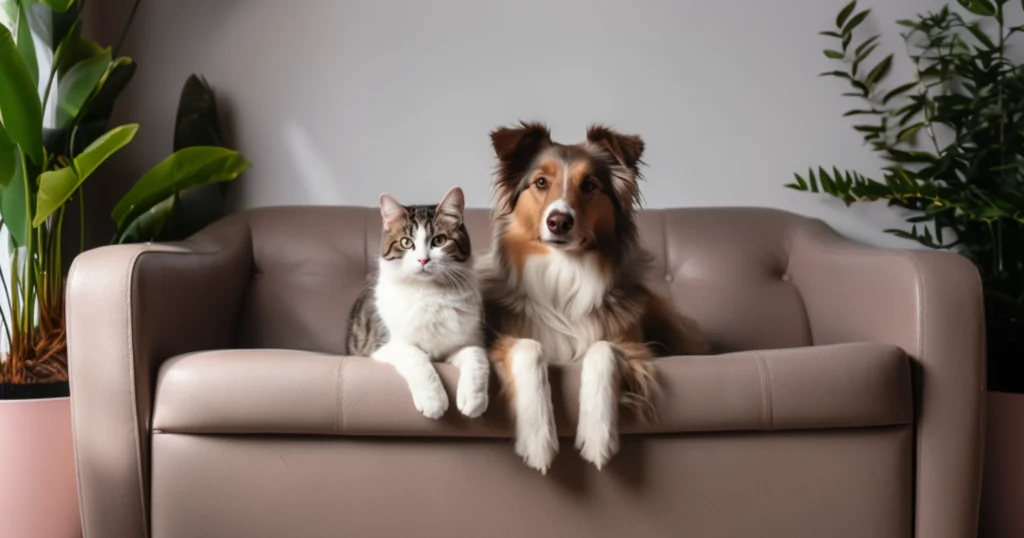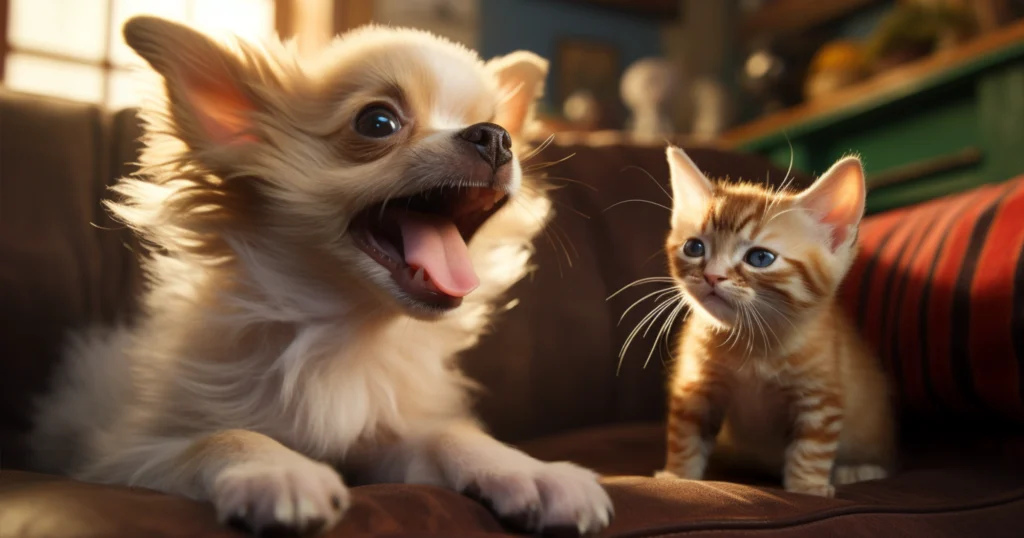Navigating the world of multi-pet households can feel like a furry minefield, particularly when figuring out how to introduce cats to dogs. The idea of ‘fighting like cats and dogs’ didn’t spring from thin air, right? This dynamic duo’s stark differences can lead to potential challenges, but with the right approach, they can become best pals.
It’s all about understanding their innate personalities, implementing effective strategies, and ensuring a harmonious environment. This guide will provide you the insights and techniques you need to create a peaceful pet paradise in your home. So, buckle up, let’s dive into the dog-cat diplomacy.
Understanding the Basics

When you’re contemplating how to introduce cats to dogs, knowing their unique personality traits becomes essential.
Dogs’ Personality Traits
Let’s start with man’s best friend, dogs. Known for their loyalty and sociability, dogs are creatures of habit. They love routines, clear structures, and are usually eager to please their human companions. Their playful and outgoing nature makes them more likely to initiate interaction. However, some breeds can be more energetic and assertive, which can overwhelm a cat, who may interpret this enthusiasm as aggression.
Cats’ Personality Traits
On the other paw, cats are independent spirits. They value their personal space and are often more reserved. Unlike dogs, they’re solitary hunters and this ancestral trait can make them more territorial. They also tend to be more cautious and suspicious of change or novelty. Sudden movements or loud noises, common in a dog’s world, can stress cats out, potentially causing clashes during the initial introduction.
Having a grip on these fundamental personality traits aids in anticipating and mitigating potential problems when introducing cats to dogs. It sets the stage for understanding the complexity of their interaction and designing the perfect strategy to bring them together. In the next section, we’ll delve into those strategies, so stick around.
Strategies for Successful Introduction

Strategizing how to introduce cats to dogs effectively is key in curating a peaceful multi-pet household. So let’s dive into it!
Preparing for the Introduction
Before the big meet, do your homework! It’s important to understand the personalities of your pets. Does your dog have a high prey drive, or is your cat particularly skittish? Familiarize yourself with their behaviors as it’ll help you predict potential roadblocks. If you’re bringing a new cat home, consider choosing one with a history of living with dogs. This can make the process smoother. Also, ensure both pets are up-to-date with their health checks. We don’t want the first encounter overshadowed by a health issue.
Initial Introduction Techniques
The first face-to-face introduction is crucial, but it doesn’t have to be face-to-face. Confused? Let me clarify. Initial introductions are often better made indirectly. Start by introducing their scents to each other. Swap bedding between them or use a soft cloth to rub each pet, then place it near the other. This way, they can investigate the new smell at their own pace.
When you think they’re ready for the first physical introduction, choose a neutral location, avoiding areas where your pets usually eat or sleep. This reduces the risk of territorial behavior. And remember, always supervise these interactions. It’s vital to intervene if signs of fear or aggression appear. But, remember to stay calm! Pets can sense your stress, and we don’t want that rubbing off on them.
Building Positive Interactions
After the first introduction, it’s time to encourage positive interactions. Regular, supervised meetings can help normalize the presence of the other pet. Initially, keep these sessions short and increase the duration as they get more comfortable.
Use positive reinforcement generously. Reward your pets with treats, praises, or petting when they behave calmly around each other. This creates a positive association with the other pet’s presence.
Do remember, each pet is an individual, and they may take their own sweet time to adjust. Patience is key here. Slow and steady wins the race, right?
By following these strategies, you’ll be on the road to a harmonious multi-pet household. But, we’re not done yet. Read on to find out how to create a conducive environment for your furry friends.
Creating a Harmonious Environment

So, you’ve managed the introductions, but how do you ensure a harmonious environment in the long run? Well, creating a pet-friendly space plays a crucial role here.
First things first, both your cat and dog need their separate spaces. You know how it is, we all value our privacy. And your pets are no different. A separate, personal area helps them feel safe and in control. A dog bed or crate for your pup, and a high perch or a secluded corner for your feline friend can work wonders.
Don’t forget about food and litter. Pets can be protective about their meals. Ensure separate feeding areas to avoid potential squabbles. And remember, cats prefer their litter box far away from their food and water, and certainly away from the dog’s sniffing range.
Toys can be a bone of contention too. Remember, dogs might chew up cat toys, and cats might be terrified of dog toys. Having separate playthings will ensure there’s no jealousy or potential choking hazards.
Exercise is key for both your pets. Regular walks and playtime for your dog and stimulating toys for your cat can help burn off excess energy. Less energy means less potential for conflicts, right?
Lastly, always ensure a safe escape route for your cat. Cats need a quick getaway option if things get heated, like a cat tree or a baby gate they can slip through.
In essence, each pet should have its resources, reducing competition and creating a stress-free environment. It’s all about understanding their needs and making slight adjustments. After all, a happy pet makes for a happy home.
Conclusion
Well, folks, that wraps up our guide on successfully introducing cats to dogs. We’ve navigated the quirks of their personalities, learned strategies for smooth introductions, and explored how to foster positive interactions. We’ve also discussed creating a pet-friendly environment, emphasizing the importance of separate spaces and resources.
Remember, there’s no rush. Take things slow, keep the atmosphere calm, and use plenty of positive reinforcement. With patience, understanding, and a sprinkle of love, you can create a harmonious multi-pet household. So, are you ready to become the master of dog-cat diplomacy? We bet you are. Happy pet parenting!


